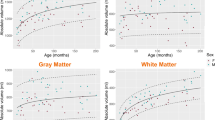Abstract
Background and purpose
This study aims to investigate the high-resolution 3-T MRI appearance and morphological variation of the temporal part of the caudate tail in pediatric subjects with normal brain MR examinations.
Patients and methods
One hundred pediatric patients were retrospectively evaluated using a high-resolution 3-T imaging protocol. Different morphological parameters including shape, size, and symmetry were evaluated. The appearance and shape of the caudate tail were classified into nodular, linear, or imperceptible. The location and relation of the caudate tail to the temporal horn and adjacent brain parenchyma were categorized. Relationships between age, gender, shape, location, side, and the cross-sectional area of the caudate tail were investigated.
Results
The caudate tail was imperceptible in 22 %, had a nodular shape in 66.5 %, and was flat in 11.5 %. There was asymmetry of the caudate tail between the two sides in 37 % of subjects. The caudate tail was completely embedded within the temporal lobe parenchyma in 8.3 %, completely protruding into the temporal horn in 27.5 %, or intermediate in 64.1 %. The mean cross-sectional area of the caudate tail was constant across ages despite the varied age range of the subjects. There was no difference in overall mean cross-sectional area of the caudate tail between the two sides.
Conclusion
There is a wide variation in the appearance of the caudate tail adjacent to the temporal horn of the lateral ventricle. Identification of anatomical variation of the caudate tail may prevent potential diagnostic pitfalls, especially with respect to subependymal heterotopia.




Similar content being viewed by others
References
Mosenthal WT (1995) A textbook of neuroanatomy with atlas and dissection guide. The Parthenon, New York, pp 166–167
Nieuwenhuys R, Voogd J, van Huijzen C (2008) The human central nervous system. Springer, Berlin, p 429
Seger CA, Cincotta CM (2005) The roles of the caudate nucleus in human classification learning. J Neurosci 16:2941–51
Yamamoto S, Monosov IE, Yasuda M, Hikosaka O (2012) What and where information in the caudate tail guides saccades to visual objects. J Neurosci 8:11005–16
Eskey CJ, Belden CJ, Pastel DA, Vossough A, Yoo AJ (2012) Neuroradiology cases. Oxford University Press, New York, p 130
Bronen R, Bagley LJ (2008) Imaging approach to the epileptic patient: avoiding pitfalls when considering differential diagnosis. In: Hodler J, von Schulthess GK, Zollikofer CL (eds) Diseases of the brain, head & neck, spine: diagnostic imaging and interventional techniques. Springer, Milan, p 88
Barkovich AJ, Kuzniecky RI (2000) Gray matter heterotopia. Neurology 55:1603–1608
Barkovich AJ, Kjos BO (1992) Gray matter heterotopias: MR characteristics and correlation with developmental and neurologic manifestations. Radiology 182:493–499
Dekaban AS, Sadowsky D (1978) Changes in brain weights during the span of human life: relation of brain weights to body heights and body weights. Ann Neurol 4:345–356
Author information
Authors and Affiliations
Corresponding author
Rights and permissions
About this article
Cite this article
Nabavizadeh, S.A., Vossough, A. High-resolution 3-T MR imaging of the temporal part of the caudate tail in children. Childs Nerv Syst 30, 485–489 (2014). https://doi.org/10.1007/s00381-013-2234-1
Received:
Accepted:
Published:
Issue Date:
DOI: https://doi.org/10.1007/s00381-013-2234-1




